Despite its location in a low-lying area, Mississippi has some high points. Top of the list is Woodall Mountain, sitting at 806 feet above sea level on the northeastern side; this is remarkable, considering that much of Mississippi doesn’t exceed 300 feet above sea level.
Woodall Mountain, or Yow Mountain as it was known back in the 1860s, is what science refers to as monadnock, meaning the material that makes up a place significantly differs from that in the surrounding region. In this case, it’s a mixture of sandstone and some iron inclusions.
What makes Woodall Mountain more fascinating is its privacy. Furthermore, it’s also home to an amazing selection of fauna and flora. Read on to find out which animals prowl Woodall Mountain.
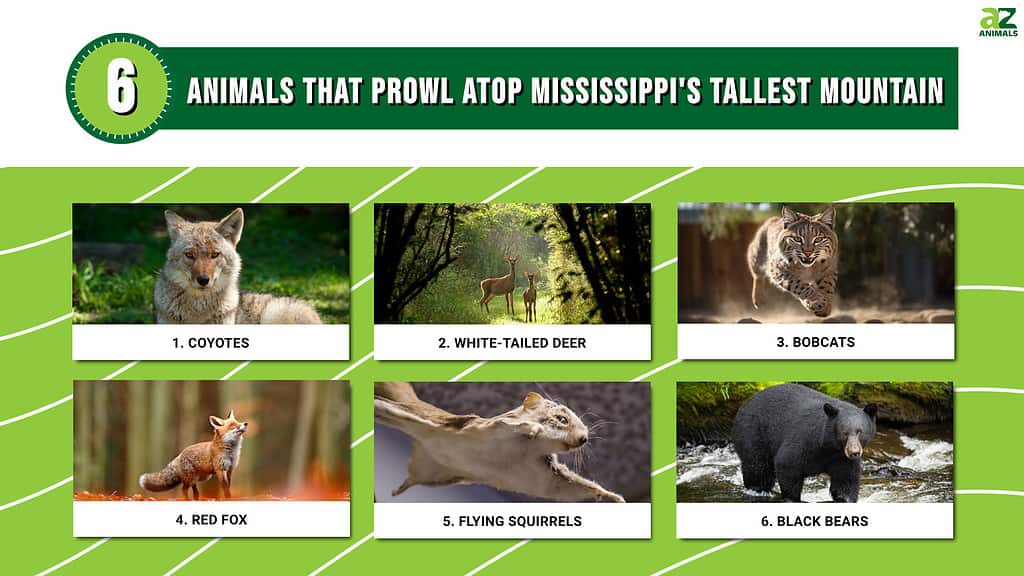
Mississippi Animals
Mississippi features a diverse landscape comprising forests, prairies, wetlands, coastal dunes, and barrier islands. Due to this rich ecosystem, it hosts a wide range of fauna and flora. There are:
- Over 84 reptile species
- 70 plus amphibian species
- Over 700 vertebrate species like the white-tailed deer, bobcat, coyote, and black bear
- Upwards of 426 bird species
- 120 fish species in the Mississippi River
- Flora includes oak trees, pine trees, tupelo trees, magnolia trees, purple coneflower, and sweet gum trees, to name a few.
However, the plant and animal species’ location depends on the environment they can best thrive in. At higher elevations, like in Woodall Mountain, you’ll not necessarily bump into all the Mississippi animals or plant life. So what should you look out for in Woodall Mountain?
Animals in Woodall Mountain
If you get a chance to visit the highest point in Mississippi, watch out for the following animals:
1. Coyotes
Coyotes are otherwise known as prairie wolves. They are predatory animals that have long been a part of human culture. Some communities believe them to be mystical creatures that possess magical powers.
Native Americans living in the southwest, California and North America have folklore that gives anthropomorphic qualities to the animal. To them, this prairie wolf has human qualities with creative, transgressive, and inventive forces. Other less appealing attributes include gluttony, trickery, and sneakiness.
Coyotes can live in diverse landscapes, including deserts, forests, mountains, and plains. Their adaptability is remarkable, considering they eat almost anything. Small prey like rabbits, rodents, and squirrels provide plenty of hunting game. In packs, they can hunt larger prey such as deer and eat garbage, pet food, insects, and fruit.
Furthermore, these animals are quite intelligent and associate humans with food availability. Thus, you’re likely to find coyotes where you find human populations, including on Woodall Mountain.
The prevalence of coyotes in Woodall Mountain is not surprising because they’re pretty common in Mississippi. In size, the animal will rarely exceed 50 pounds and four feet in length. They’re easy to spot due to their distinctive brownish-gray fur, bushy tails, and pointed ears. But the distinctive howl will echo across the mountainsides even if you don’t see one.
The animal is most active at night, but spotting them during the day isn’t uncommon. They’ll, however, keep away from areas with high human activity. Indeed, coyotes aren’t a threat to human beings. Unfortunately, the same does not go for small livestock and pets.
If you’re taking a dog on a Woodall Mountain hike, please keep it on a leash.
Mississippi allows the hunting or trapping of coyotes, but you must get the necessary permits and licenses. Also, take time to understand the different regulations governing the hunting or trapping of coyotes.

This coyote is enjoying the peacefulness of a grassy field in Mississippi.
©iStock.com/GatorDawg
2. The White-Tailed Deer
The beautiful white-tailed or Virginia deer is also Mississippi’s official land mammal. The state bequeathed the honor to the animal in 1974. The deer plays a significant role in the ecological and aesthetics of the state’s natural heritage.
The white-tailed deer adult males or bucks typically weigh between 150 to 300 pounds and will grow to seven feet long. Females are smaller, rarely exceeding 200 pounds and six feet in length.
White-tailed deer are hunters’ favorites due to their lush fur, although the state regulates the activity. Deer are also a food source for predators like wolves, bobcats, and coyotes. Despite these threats, the hardy animals continue to thrive, reaching populations of upwards of 1.75 million in Mississippi.
Surprisingly enough, the deer gets its name from its tail. But, if you’re looking at it from an aerial view, all you see is a brown animal, including the tail. Yet, when fleeing a predator or in an alarmed state, this ungulate beauty will raise its tail, exposing the white underneath.
Like the coyote, white-tailed deer can live in almost any environment. You’ll often find them in meadows, grassy fields, or areas with coniferous forests. Their diet typically consists of flowers, leaves, weeds, and grass. They’ll also consume fruit, nuts, and corn in warmer months.
White-tailed deer are standard features during the day because that is when they’re most active. No matter how docile they look, wild deer will protect themself if they feel threatened. The bucks grow antlers, and this can be a deadly weapon. So, make sure you give the animals plenty of space.

This majestic animal is one of nature’s most beautiful creatures! The white-tailed deer is easily recognizable by its long, white tail.
©Tom Reichner/Shutterstock.com
3. Bobcats
Bobcats adapt very well to woodland habitats, making Woodall Mountain an ideal home. You’ll also find them in deserts and swamps.
The bobcat does not grow very big, at about 30 pounds and 3 feet long. The medium-sized predators are skilled hunters whose diet comprises squirrels, rodents, and other small mammals. But they’ll mix their diet with reptiles, birds, and deer.
Spotting a bobcat is difficult due to its elusive nature. They’re quite active at dawn and dusk. So, if you bump into one during your Woodall hikes, give it space for your safety. By nature, it won’t attack unless it sees you as a threat. You’ll also want to keep a close eye on small pets and children.
Bobcats in Mississippi are a protected species; thus, regulations on the trapping or hunting of these magnificent creatures. The Mississippi Department of Wildlife, Fisheries, and Parks takes an active interest in the Bobcat population in Woodland Mountain. The officials undertake constant monitoring of the Bobcat populations and health assessments.
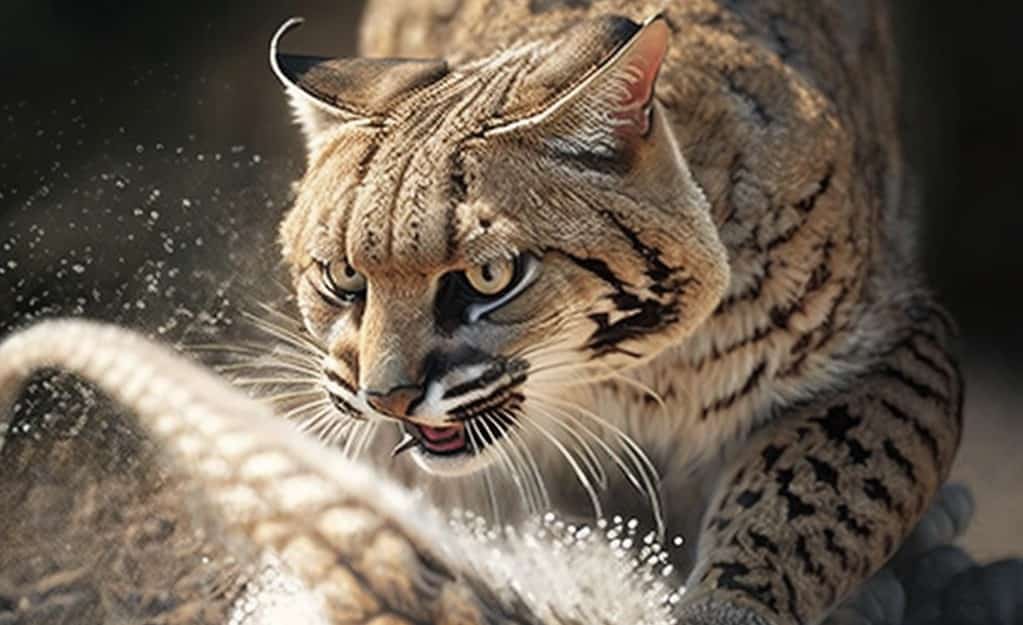
4. Red Fox
Red foxes are common in North America and Mississippi’s Woodall Mountain. The relatively tiny animals weigh 8 to 15 pounds and are about four feet long.
Unlike their relatives, the coyotes, red foxes aren’t picky eaters. They’re scavengers and opportunistic predators, existing on reptiles, birds, insects, and carrion. They also have no qualms about raiding trash cans for food.
Red foxes operate on a 24-hour clock, although primarily, they’re nocturnal. The distinctive red, lush coats, pointed ears, and white-tipped tail are a quick giveaway to their identity.
Please note that red foxes are protected species in Mississippi. Any hunting or trapping falls under state regulation. Apply the same level of caution when you bump into a red fox as you would with a bobcat, including keeping small pets on a leash and constant supervision.
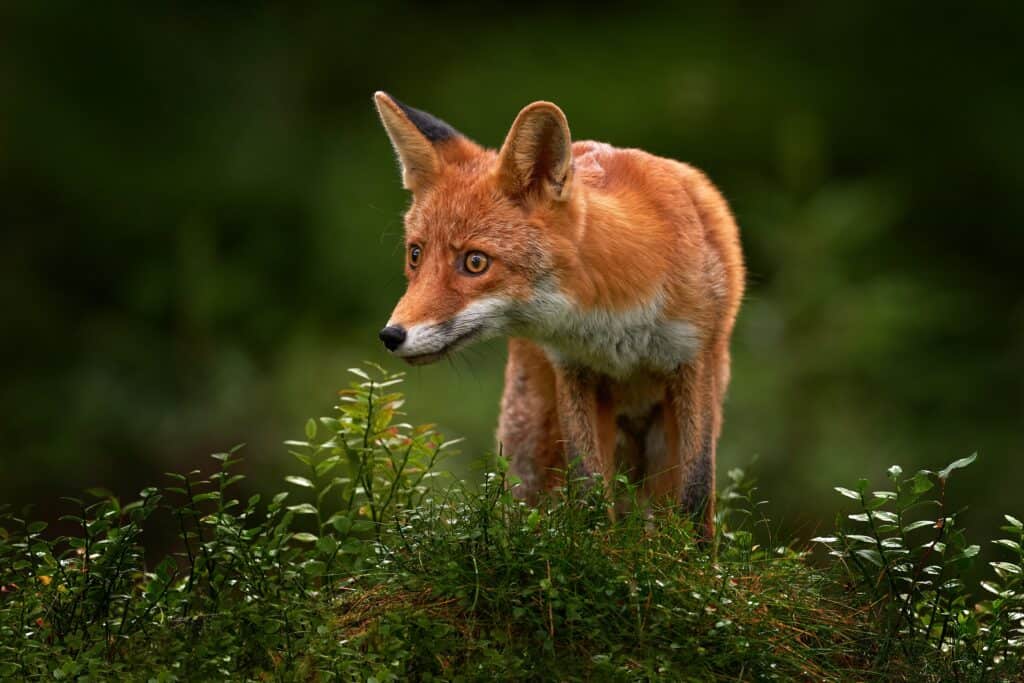
A red fox standing in a lush, green forest. It has its head raised, looking alert and curious.
©Ondrej Prosicky/Shutterstock.com
5. Flying Squirrels
Two species of flying squirrels peacefully coexist in Woodall Mountain. These are the southern and northern flying squirrels. In terms of population, southern flying squirrels are more. Their natural habitats primarily consist of forested areas with mature trees and dense underbrush.
The flying squirrel’s name may be deceiving as it would be easy to imagine they actually fly. But these fascinating creatures have a thin membrane stretching from the front two hind legs. It allows them to glide, thus mimicking a flying motion. They can easily reach heights of 60 feet or 150 feet in horizontal movement.
Flying squirrels are pretty small, rarely exceeding four ounces in weight, and about 10 inches, including the tail for adults. The creatures are nocturnal and spend a lot of time in the trees. They’re omnivorous, depending on insects, fruits, nuts, and bird eggs for nutrition.
You’ll not have a chance to interact much with flying squirrels due to their need for privacy. Please don’t try to trap one to keep as a pet because it’s illegal in many states.

A furry brown and white flying
squirrel
soaring through the air.
©Laura Fiorillo/Shutterstock.com
6. Black Bears
Black bear populations are common in Mississippi and Woodall Mountain. Despite the name, some are dark brown, while others have lighter quotes.
An adult black bear can weigh about 660 pounds and is about 6 feet tall. The females are smaller, though. Also, please note that size variations may occur due to geographic location and age.
As omnivorous animals, they live on small mammals, insects, nuts, and berries. They’re also avid scavengers and will actively look for carrion. The black bears can also be a nuisance around homes because of their habit of raiding trash cans.
Black bears look for food during the day and night. They’re solitary animals and prefer to hang around in small family groups. Mississippi prohibits the hunting of black bears. Give the animal a respectful and wide berth if you see it on Woodall Mountain.
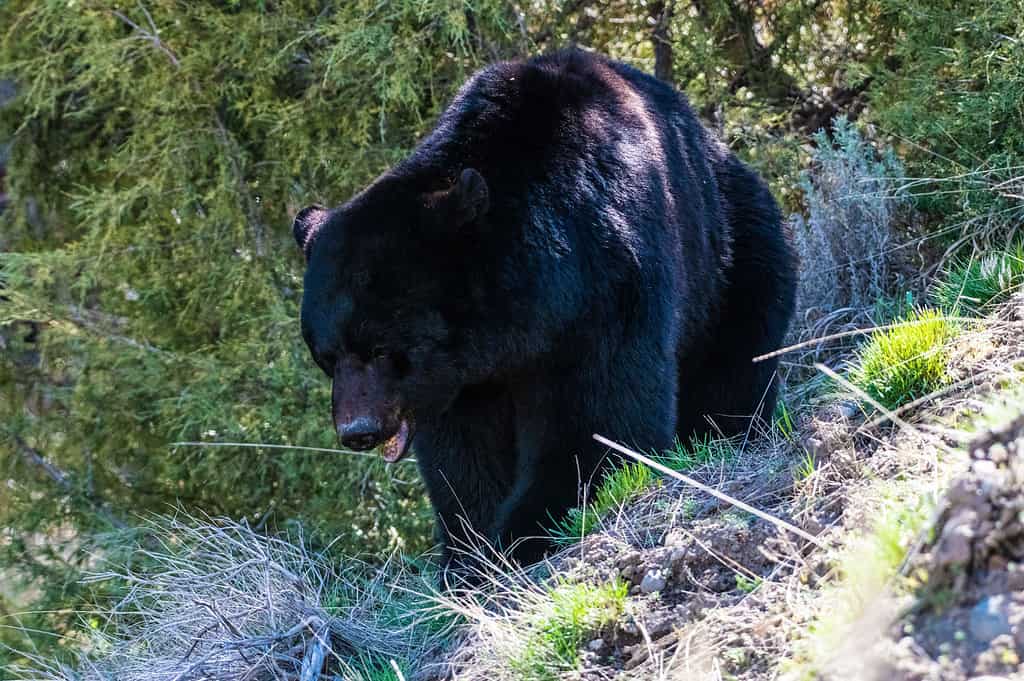
A black bear walking through a dense forest with trees and foliage.
©iStock.com/John Morrison
Snakes in Woodall Mountain
Mississippi is home to several snakes, some of them venomous. Please wear protective clothing such as boots and long pants to avoid snake bites. Also, pay attention to your steps to avoid stepping on one. Snakes tend to nestle under leaves and will not always be visible.
Notable snake species on Woodall Mountain include the following:
- The eastern or black rat snake is a non-venomous dark brown or black species. An adult one will reach about six feet in length.
- Copperheads are venomous and are easy to spot due to their distinctive copper-colored head. Wooded areas are their preferred habitats; though rare, the bite can be fatal.
- Timber rattlesnakes are venomous and prefer wooded areas. If you get too close, you’ll hear the distinctive, warning rattle of the tails.
- The Eastern coral snake is venomous with red, yellow, or black banding. Though not common, some people have spotted some on Woodall Mountain.
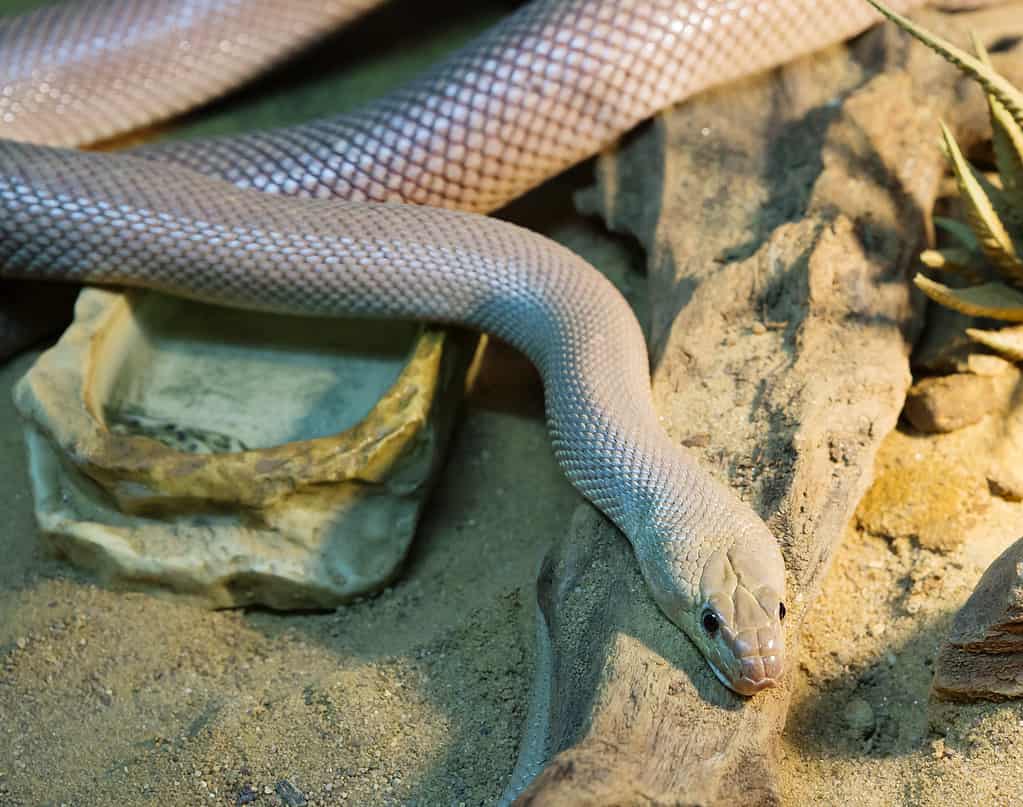
Close-up of a rat snake coiled up on the ground. Its body has an iridescent sheen to it.
©iStock.com/User10095428_393
Insects on Woodall Mountain
These insects contribute to the fauna on Woodall Mountain. As in the case of snakes, wear protective clothing and carry insect repellent to avoid stings and bites.
- Butterflies include the eastern tiger swallowtail, monarch butterfly, and black swallowtail.
- Beatles, like the eastern Hercules beetle, are one of the largest beetle species in North America.
- Ants such as the imported fire ant, which has a nasty sting.
- Mosquitoes are common, especially in the wetland Woodall areas during summer.
- Bees and wasps such as bumblebees, paper wasps, and honey bees are prevalent on Woodfall Mountain.
- Spiders like wolf spiders, jumping spiders, and orb weavers.
- Cicadas have a distinctive buzzing sound and more.
Bird Species in Woodall Mountain
While they may not stalk the mountaintop, birds are an important part of Woodall Mountain. Common species include:
- Red-tailed Hawk
- Eastern Bluebird
- American Goldfinch
- Ruby-throated Hummingbird
- Carolina Chickadee
- Northern Cardinal
- American Crow
- Eastern Screech Owl
We can’t ignore the vital role of birds in maintaining the ecosystem. They’re critical to seed dispersal, pollination, and pest control. Scientists also refer to their presence as an indicator of a healthy ecosystem.

Eastern Bluebirds can be found in semi-open areas with sporadic trees, farmland, and other habitat types.
©iStock.com/SteveByland
Flora on Woodall Mountain
Mississippi has native trees like white oak, sweetgum, shortleaf pine, black gum water oak, and southern red oak. You’ll find most of these trees in Woodall Mountain, including the following.
Oak Trees
Oak trees are the homes of various animal species, such as birds, squirrels, and deer. Common ones in Woodall Mountain are white, red, and post oak.
During winter, the deciduous trees will lose their leaves. A typical oak tree can grow quite large, often reaching 100 feet. For a long time, people have used oak for furniture making and construction due to the strong, dense wood.
Hickory Trees
Hickory trees are common in Woodall Mountain. Common species include mockernut. shagbark and pignut hickory.
Besides serving as homes to wildlife, hickory nuts are essential food sources for chipmunks, squirrels, and other rodents. Deer and other browsing animals eat the leaves and twigs.
Dogwood Trees
Dogwood trees stand out due to their beautiful flowers, which are pink or white. The tree berries provide food for birds and other animals.
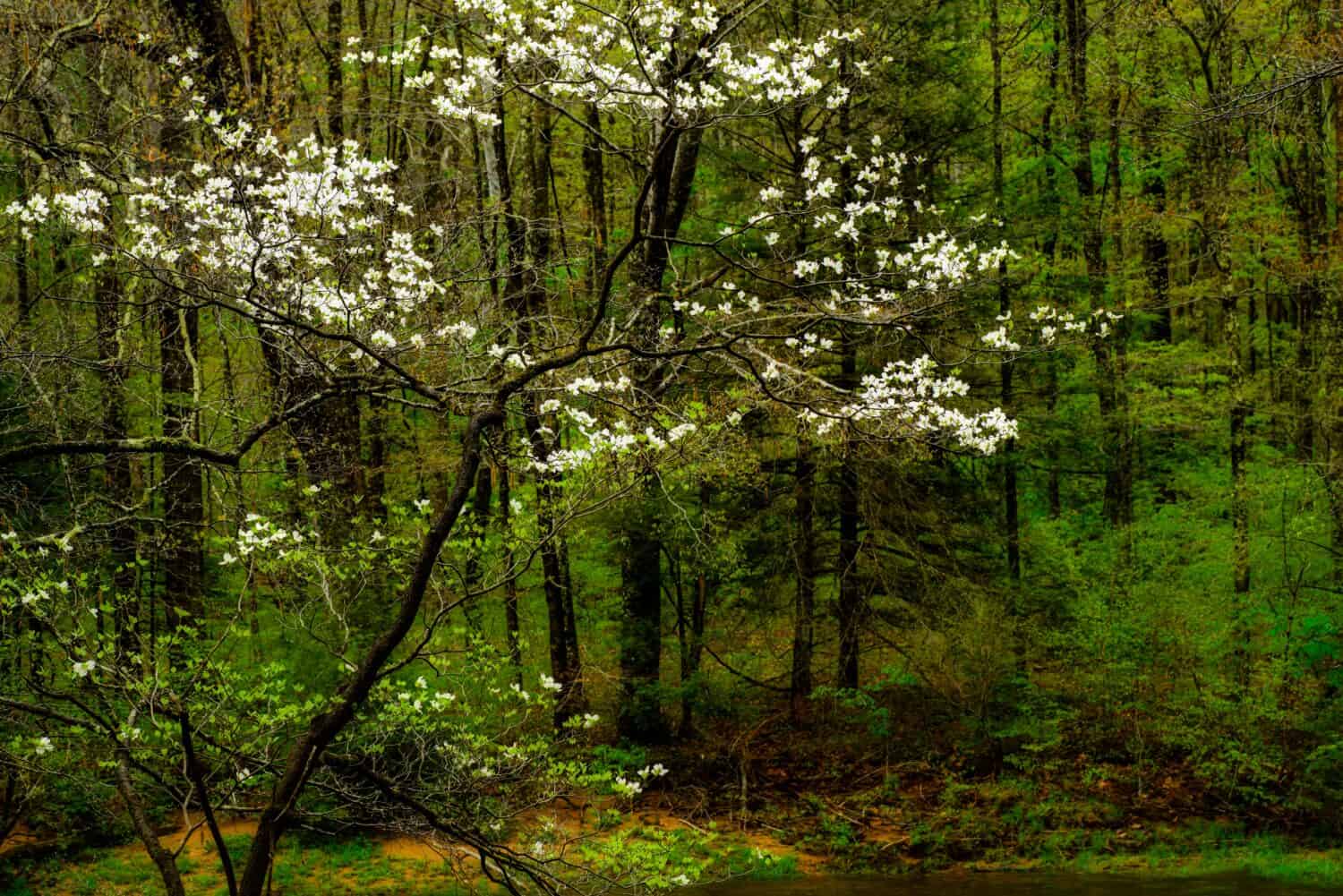
White dogwoods look like lace in a green forest.
Image: Malachi Jacobs, Shutterstock
©Malachi Jacobs/Shutterstock.com
Wildflowers
Woodall Mountain is a sight to behold when flowers are in full bloom. Common ones include:
- The vibrant orange butterfly weed.
- Purple coneflower belongs to the daisy family.
- The delicate pink wild geranium.
- The bright-yellow black-eyed Susan.
- Wild indigo produces clusters of blue and purple flowers.
- Woodland phlox is a pink and purple flower.
Beyond the aesthetics, wildflowers are an essential food source for butterflies, hummingbirds, bees, and more. Other plant species in Woodall Mountain include grass species like bluestem, switchgrass, and Indian grass. Ferns like Christmas and maidenhair fern are also common. Shrubs like American Beautyberry also contribute to the abundance of flora.
Woodall Mountain is Home to a Wide Range of Animal and Plant Species
The highest part of Mississippi, Woodall Mountain, is home to many plant and animal species. These include various mammals, snakes, birds, and insects and an abundance of trees, shrubs, ferns, and wildflowers.
Finally, we end by sending out an appeal to everyone. We all must take an active role in protecting the natural ecosystems. Hunting, trapping of animals, and deforestation are depleting such resources. States, including Mississippi, do their part by passing regulations to protect some animals. Nevertheless, you must also play your part to ensure sustainability.
Summary of 6 Animals That Prowl Atop Mississippi’s Tallest Mountain
| Animal | Interesting Facts | |
|---|---|---|
| 1 | Coyotes | Coyotes prey on pets – make sure your dog is on a leash |
| 2 | White-Tailed Deer | Despite being hunted by humans and animals – there are more than 1.75 million deer in Mississippi |
| 3 | Bobcats | Your best chances of seeing a bobcat are at dawn and dusk |
| 4 | Red Fox | Red foxes use a blood-curdling scream to attract mates |
| 5 | Flying Squirrels | It is illegal to keep a flying squirrel as a pet |
| 6 | Black Bears | At up to 6 feet tall and 600 pounds – it is wise to give a black bear a wide berth |
The photo featured at the top of this post is © iStock.com/lightphoto
Thank you for reading! Have some feedback for us? Contact the AZ Animals editorial team.






